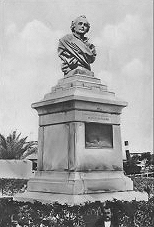Thomas Fletcher Waghorn – 20th June 1800 -7th January 1850

Thomas
Waghorn, born in Chatham, was an English sailor, navy officer, and postal
pioneer who promoted and claimed the idea of a new route from England
to India overland through Egypt prior to the development of the Suez
Canal. Waghorn claimed to have demonstrated the route for the first
time in 1829-30 and that it reduced the journey from over 11,000 miles
to 6,000 miles, and while steamships around the Cape of Good Hope took
about three months, his route took between 35 and 45 days.
At twelve years old, he entered the Royal Navy at Chatham, joining the frigate ‘Tigris’ and then as a midshipman on the HMS Bahama in November 1812. He became a third mate on a freed trader and moved to Calcutta. In 1819 he joined the Bengal Marine Pilot Service and in 1824 he served during the Arakan War with the navy. Commanding a Company cutter, ‘Matchless’, he mounted a 12-pounder gun onto a rocky island in the Arakan River that came to be called “Waghorn’s Rock”. Sickness forced him to take leave in 1827 when he took an interest in the early attempts at establishing a steamship route from England to India and the East. Lord Combermere put Waghorn in charge of taking the idea forward in England. Retiring from naval duties as a lieutenant in 1832, he made several trips between England and India via Egypt to find ways to move letters and post. When Waghorn first took the overland route through Egypt, connecting the Mediterranean to the Red Sea he announced his intention of completing the journey to India in 90 days but was foiled when the steamship he was due to meet at Suez failed to arrive. But he did not give up. He set up an agency in Cornhill, London in 1835 for conveying post and passengers to India via Egypt. During that time he lived among Arabs in the desert and laid the foundations for the overland route, building rest-houses and supplying guides, steamboats, horses and carriages for travellers. The route was primarily used as a postal service, and the transport of passengers did not provide much comfort – a 24 hour ride across a hot desert with camels and donkeys. Waghorn also had to negotiate with the local Bedouins for safe passage even though he had Mehmet Ali, the Pasha of Egypt’s, official government blessing. Rivals soon cut into his business and forced him into a merger. In 1840, P&O set up in competition with him, backed by the British government and in 1844, he was out of business. Then came another setback; 300 horses died in a plague. It was the end for him and the Pasha bought him out. He died in Islington,London in 1850, his legacy only a few thousand letters stamped “The Overland Route c/o Mr Waghorn” In 1869, Ferdinand de Lessep’s had a statue of Waghorn made and installed to honour his achievements. Situated in the southern end of the Suez Canal at Port Tewfik there the statue stood until It was destroyed during the 1956 Suez Crisis |